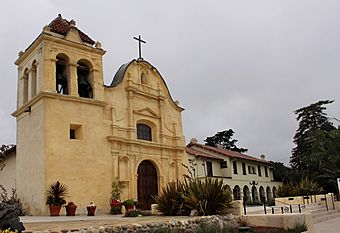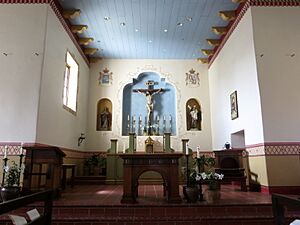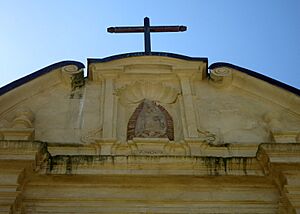Cathedral of San Carlos Borromeo (Monterey, California) facts for kids
|
Royal Presidio Chapel
|
|

The Cathedral of San Carlos Borromeo from the northeast
|
|
| Location | 550 Church Street, Monterey, California |
|---|---|
| Area | 0.5 acres (0.20 ha) |
| Built | 1791-1794 |
| Architectural style | Spanish Colonial |
| NRHP reference No. | 66000216 |
Quick facts for kids Significant dates |
|
| Added to NRHP | October 15, 1966 |
| Designated NHL | October 9, 1960 |
The Cathedral of San Carlos Borromeo, also known as the Royal Presidio Chapel, is a Catholic church in Monterey, California. It is very old and important! This cathedral is the oldest church in California that has been open and used continuously. It is also the oldest building made of stone in the state.
The church was built between 1791 and 1794. This makes it one of the oldest cathedrals still in use in the United States. It is also the smallest cathedral in the country. It is the only original chapel left from the old Monterey Presidio. A "presidio" was like a fort or military base in Spanish times.
Contents
A Look Back: How the Cathedral Started
The church was first started by a Franciscan priest named Saint Junípero Serra. He founded it as a chapel for the Mission San Carlos Borromeo de Carmelo on June 3, 1770. Father Serra first built the mission in Monterey, close to a native village called Tamo.
However, Father Serra had some disagreements with the military governor, Pedro Fages. Governor Fages was in charge of Alta California from 1770 to 1774. Because of these disagreements, Father Serra decided to move the mission. In May 1771, the Spanish ruler approved his plan. The mission was moved to its current spot near the Carmel River. This is close to the town of Carmel-by-the-Sea, California today.
When the mission moved, the original wooden and adobe building became the San Jose Chapel. It served the Presidio of Monterey. In 1777, Monterey became the capital of the Californias region. The chapel was then renamed the Royal Presidio Chapel.
The first church building was destroyed by a fire in 1789. This fire was accidentally caused by a salute gun. A new stone building was then built between 1791 and 1795. Native American workers helped complete it in 1794. In 1840, the chapel was given a new dedication to Saint Charles Borromeo.
In 1849, the chapel was chosen to be the main church for the Diocese of Monterey. This meant it became a "Pro-Cathedral." Later, the bishop moved the main church to Mission Santa Barbara. This was done to be closer to the growing population in Los Angeles.
A Presidential Wedding Connection

Did you know a future US President had a connection to this chapel? Herbert Hoover, who later became President of the United States, married Lou Henry on February 10, 1899. The wedding was performed by Father Ramon Mestres, who worked at the chapel.
The wedding did not happen inside the chapel itself. It took place at the Henry family home. Father Mestres was allowed to perform the ceremony even though it was a civil wedding. This was because there was no Protestant minister in town at the time.
Amazing Architecture and Design

The Royal Presidio Chapel was the first building in California made of stone. It shows off the beautiful Spanish Colonial style from the late 1700s. You can also see influences from Moorish architecture in its design.
The church has amazing arches and doorways carved from sandstone. These details make it very special and many people think it is the most beautiful of all the California Missions. A lovely garden surrounds the church. There is a path that leads around the building and to the San Carlos School.
At the back of the church, you can find the Junipero Oak. This is a famous California landmark. The church also has a bell tower to call people to Mass. High up on the front of the church, there is a statue of Our Lady of Guadalupe. This is the oldest non-native sculpture in California.
Important Historical Connections
- The Vizcaíno-Serra Oak: The remains of a very old tree are kept near the cathedral. This tree is connected to the early history of Monterey.
- San Carlos School: This school is on the cathedral grounds. It was started in 1898 by a group of nuns. Today, it is run by the San Carlos Cathedral.
Historic Recognitions
In 1960, the chapel was recognized as a National Historic Landmark. This means it is a very important historical place in the United States. It was added to the National Register of Historic Places.
The chapel became the main church for the Diocese of Monterey again in 1967. This happened when the larger Diocese of Monterey-Fresno was divided into two separate areas. As mentioned before, this cathedral is the smallest in the contiguous United States. It is also one of the two oldest buildings still serving as a cathedral in the country.
The Royal Presidio Chapel is also recognized as:
- California Historical Landmark #105 — Royal Presidio Chapel
- California Historical Landmark #128 — Landing Place of Sebastian Vizcaíno and Fray Junípero Serra
Restoring the Cathedral
A detailed report about the building was finished in 1999. It looked at the church's history, its current condition, and what needed to be done to protect it.
Money for the restoration came from several groups and private donations. In May 2007, a concrete area around the church was removed. This concrete had been trapping moisture in the walls. A special drain system was built to keep water away from the sandstone walls. The roof was also removed to fix damage from termites and to add new supports.
Workers carefully removed the plaster from the original stone walls. They found that the main walls, built in 1794, were in much better shape. However, parts added in 1858 needed more work. About 80% of the back walls were replaced with new stone and mortar.
The church also got a "seismic retrofit." This means it was made stronger to better withstand earthquakes. Steel bars were put into the walls to reinforce them. During the restoration, experts also found that the inside of the church used to be much more decorated than they thought!
See also
 In Spanish: Catedral de San Carlos Borromeo (Monterrey) para niños
In Spanish: Catedral de San Carlos Borromeo (Monterrey) para niños
- List of Catholic cathedrals in the United States
- List of cathedrals in the United States
- Former California State Capitol sites


